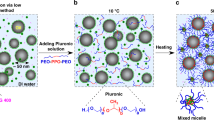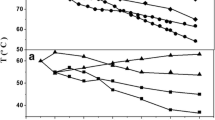Abstract
Polydimethylsiloxane-poly(methacrylic acid—hydroxyethyl methacrylate) interpenetrating polymer networks (PDMS-P(MAA–HEMA) IPN) were formulated and polymerized simultaneously from bicontinuous microemulsion templates. Microemulsions containing reactive silicone oils and MAA/HEMA in aqueous solution were stabilized with silicone surfactants, and were then reacted at 50 °C for 3 h under an N2 atmosphere. The formation of bicontinuous morphology was confirmed by laser scanning confocal microscopy, reversible swelling behavior, differential scanning calorimetry, texture analysis, and permeability to vitamin B12 in aqueous solution. Incorporating polymerizable surfactants into the microemulsion aided in stabilizing the initial microemulsion structure during polymerization, yielding a more uniform IPN morphology with domain sizes of <200 nm at equilibrium swelling. The process developed here demonstrates a simple, single-step polymerization approach to forming IPNs from low viscosity microemulsion templates, and could potentially be extended to a variety of hydrophilic and hydrophobic monomers.













Similar content being viewed by others
References
Sperling LH, Mishra V (1996) The current status of interpenetrating polymer networks. Polym Adv Technol 7:197–208
Lucas P, Robin J (2007) Silicone-based polymer blends: an overview of the materials and processes. Adv Polym Sci 209:111–147
Kim SC, Klempner D, Frisch KS, Radigan W, Frisch HL (1976) Polyurethane interpenetrating polymer networks. I. synthesis and morphology of polyurethane-poly(methyl methacrylate) interpenetrating polymer networks. Macromolecules 9:258–263
Klempner D, Frisch KC (1990) Advances in interpenetrating polymer networks. Technomic Publishing, Lancaster
Lee JH, Kim SC (1986) Hydrophilic-hydrophobic interpenetrating polymer networks (IPN's) synthesized under high pressure. 1. morphology, dynamic mechanical properties, and swelling behavior of polyurethane-polystyrene IPN's. Macromolecules 19:644–648
Sperling LH (1981) Interpenetrating polymer networks and related materials. Plenum, New York
Zhang X, Wu D, Chu C (2004) Synthesis, characterization and controlled drug release of thermosensitive IPN–PNIPAAm hydrogels. Biomaterials 25:3793–3805
Abbasi F, Mirzadeh H, Katbab AA (2002) Sequential interpenetrating polymer networks of poly(2-hydroxyethyl methacrylate) and polydimethylsiloxane. J Appl Polym Sci 85:1825–1831
Pavlyuchenko VN, Sorochinskaya OV, Ivanchev SS, Khaikin SY, Trounov VA, Lebedev VT, Sosnov EA, Gofman IV (2009) New silicone hydrogels based on interpenetrating polymer networks comprising polysiloxane and poly(vinyl alcohol) networks. Polym Adv Technol 20:367–377
Liu L, Sheardown H (2005) Glucose permeable poly (dimethyl siloxane) poly (N-isopropyl acrylamide) interpenetrating networks as ophthalmic biomaterials. Biomaterials 26:233–244
Turner JS, Cheng Y (2000) Preparation of PDMS-PMAA interpenetrating polymer network membranes using the monomer immersion method. Macromolecules 33:3714–3718
Turner JS, Cheng Y (2003) Morphology of PDMS-PMAA IPN membranes. Macromolecules 36:1962–1966
Hoar TP, Schulman JH (1943) Transparent water-in-oil dispersions: the oleopathic hydro-micelle [1]. Nature 152:102–103
Danielsson I, Lindman B (1981) The definition of microemulsion. Colloids Surf 3:391–392
Winsor PA (1954) Solvent properties of amphiphilic compounds. Butterworths, London
Winsor PA (1948) Hydrotropy, solubilisation and related emulsification processes. Trans Faraday Soc 44:376–398
Salager J-L, Antón RE, Sabatini DA, Harwell JH, Acosta EJ, Tolosa LI (2005) Enhancing solubilization in microemulsions—state of the art and current trends. J Surfact Deterg 8:3–21
Holmberg K (1997) Microemulsions in biotechnology. In: Solans C, Kunieda H (eds) Industrial application of microemulsions. Marcel Dekker, New York, p 69
Lawrence MJ, Rees GD (2000) Microemulsion-based media as novel drug delivery systems. Adv Drug Delivery Rev 45:89–121
Chow PY, Gan LM (2005) Microemulsion polymerization and reaction. In: Okubo M (ed) Polymer particles. Springer, Berlin, p 257
Chew CH, Li TD, Gan LH, Quek CH, Gan LM (1998) Bicontinuous-nanostructured polymeric materials from microemulsion polymerization. Langmuir 14:6068–6076
Guerrero-Ramírez LG, Nuño-Donlucas SM, Cesteros LC, Katime I (2008) Smart copolymeric nanohydrogels: synthesis, characterization and properties. Mater Chem Phys 112:1088–1092
O'Donnell J, Kaler EW (2008) Microstructure evolution and monomer partitioning in reversible addition–fragmentation chain transfer microemulsion polymerization. Macromolecules 41:6094–6099
Jones BH, Lodge TP (2010) Nanoporous materials derived from polymeric bicontinuous microemulsions. Chem Mater 22:1279–1281
Yang J, Shu W-B, Qin W (2010) Research on porous materials from bicontinuous microemulsion polymerization. J Funct Mat 41:148–152
Peinado C, Bosch P, Martin V, Corrales T (2006) Photoinitiated polymerization in bicontinuous microemulsions: fluorescence monitoring. J Polym Sci Part A 44:5291–5303
Wang H-J, Li D-S, Peng M (2008) Preparation of bicontinuous porous polymeric materials via microemulsion polymerization. Polym Mat Sci Eng 24:70–73
Summers M, Eastoe J, Davis S, Du Z, Richardson RM, Heenan RK, Steytler D, Grillo I (2001) Polymerization of cationic surfactant phases. Langmuir 17:5388–5397
Gao F, Ho C, Co CC (2006) Polymerization in bicontinuous microemulsion glasses. Macromolecules 39:9467–9472
Stubenrauch C, Tessendorf R, Strey R, Lynch I, Dawson KA (2007) Gelled polymerizable microemulsions. 1. Phase behavior. Langmuir 23:7730–7737
Stubenrauch C, Tessendorf R, Salvati A, Topgaard D, Sottmann T, Strey R, Lynch I (2008) Gelled polymerizable microemulsions. 2. Microstructure. Langmuir 24:8473–8482
Magno M, Tessendorf R, Medronho B, Miguel MG, Stubenrauch C (2009) Gelled polymerizable microemulsions. 3. Rheology. Soft Matter 5:4763–4772
Acosta E, Brooks M, Castellino V, Chen Y, Cheng Y-L, Li N, Whinton M. (2011) Interpenetrating network silicone hydrogels. Canadian Provisional Patent Applicaton.
Brook MA, Whinton M, Gonzaga F, Li N (2011) Elastomeric hydrogels by polymerizing silicone microemulsions. Chem Commun 47:8874–8876
Castellino V, Cheng Y-L, Acosta E (2010) The hydrophobicity of silicone-based oils and surfactants and their use in reactive microemulsions. J Colloid Interface Sci 353:196–205
Siltech LLC, Emulsifiers. http://www.siltechmfg.net/emulsifiers_page.html. Accessed 21 May 2012.
Siltech LLC, Formulator friendly reactive intermediates. Available online at http://www.siltechpersonalcare.com/pdfs/products/Reactive_Silicones.pdf. Accessed 21 May 2012.
Acosta E, Uchiyama H, Sabatini DA, Harwell JH (2002) The role of hydrophilic linkers. J Surfactants Deterg 5:151–157
Acosta EJ, Harwell JH, Sabatini DA (2004) Self-assembly in linker-modified microemulsions. J Colloid Interface Sci 274:652–664
Acosta EJ, Nguyen T, Witthayapanyanon A, Harwell JH, Sabatini DA (2005) Linker-based bio-compatible microemulsions. Environ Sci Technol 39:1275–1282
Lim WH (2006) Phase diagram, viscosity and conductivity of α-sulfonate methyl esters derived from palm stearin/1-butanol/alkane/water systems. J Surfactants Deterg 9:349–355
Meier W (1997) Structure of w/o-microemulsion templated polymer networks. Colloid Polym Sci 275:530–536
Laguës M, Sauterey C (1980) Percolation transition in water in oil microemulsions. Electrical conductivity measurements. J Phys Chem 84:3503–3508
Clausse M, Peyrelasse J, Heil J, Boned C, Lagourette B (1981) Bicontinuous structure zones in microemulsions. Nature 293:636–638
Deutch-Kolevzon R, Aserin A, Garti N (2011) Synergistic cosolubilization of omega-3 fatty acid esters and CoQ10 in dilutable microemulsions. Chem Phys Lipids 164:654–663
Gasperlin M, Bester-Rogac M (2009) Physicochemical characterization of pharmaceutically acceptable microemulsions: tween 40/Imwitor308/Isopropyl myristate/water. In: Fanum M (ed) Microemulsions properties and applications. CRC Press, Boca Raton, p 293
Teubner M, Strey R (1987) Origin of the scattering peak in microemulsions. J Chem Phys 87:3195–3199
DeGennes PG, Taupin C (1982) Micro-emulsions and the flexibility of oil–water interfaces. J Phys Chem 86:2294–2304
Sottmann T, Strey R, Chen S (1996) A small-angle neutron scattering study of nonionic surfactant molecules at the water-oil interface: area per molecule, microemulsion domain size, and rigidity. J Chem Phys 106:6483–6491
Zemb T (2009) Flexibility, persistence length and bicontinuous microstructures in microemulsions. C R Chim 12:218–224
Guest D, Auvray L, Langevin D (1985) Persistence length measurements in middle phase microemulsions. J Phys Lett 46:1055–1063
Gentle TE, Snow SA (1995) Adsorption of small silicone polyether surfactants at the air/water interface. Langmuir 11:2905–2910
Rosen MJ (2004) Surfactants and interfacial phenomena, 3rd edn. Wiley, New York
Li B, Jiang Y, Liu Y, Wu Y, Yu H, Zhu M (2009) Novel poly(N-isopropylacrylamide)/clay/poly(acrylamide) IPN hydrogels with the response rate and drug release controlled by clay content. J Polym Sci B 47:96–106
Haraguchi K, Li H, Song L, Murata K (2007) Tunable optical and swelling/deswelling properties associated with control of the coil-to-globule transition of poly(N-isopropylacrylamide) in polymer—clay nanocomposite gels. Macromolecules 40:6973–6980
Gehrke SH, Cussler EL (1989) Mass transfer in pH-sensitive hydrogels. Chem Eng Sci 44:559–566
Dembczynski R, Jankowski T (2000) Characterisation of small molecules diffusion in hydrogel-membrane liquid-core capsules. Biochem Eng J 6:41–44
Colton CK, Smith KA, Merrill EW, Farrell PC (1971) Permeability studies with cellulosic membranes. J Biomed Mater Res 5:459–488
Turner JS, Cheng Y-L (2004) pH dependence of PDMS-PMAA IPN morphology and transport properties. J Membr Sci 240:19–24
Acknowledgments
We thank Siltech Corp. and Rick Vrckovnik for providing the silicone alkyl polyether and silicone acrylate surfactants and supporting technical literature used in this work. The authors thank Silvia Zarate and Oliver Chung for their technical assistance with the FTIR and SAXS characterization. This work was supported by the National Science and Engineering Research Council of Canada (NSERC) and the 20/20 NSERC Ophthalmic Materials Network.
Author information
Authors and Affiliations
Corresponding author
Rights and permissions
About this article
Cite this article
Castellino, V., Acosta, E. & Cheng, YL. Interpenetrating polymer networks templated on bicontinuous microemulsions containing silicone oil, methacrylic acid, and hydroxyethyl methacrylate. Colloid Polym Sci 291, 527–539 (2013). https://doi.org/10.1007/s00396-012-2741-8
Received:
Revised:
Accepted:
Published:
Issue Date:
DOI: https://doi.org/10.1007/s00396-012-2741-8




